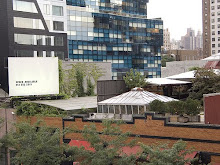
 Views of the Federal Building, 2009
Views of the Federal Building, 2009
The Department of Homeland Security is a branch of the government dedicated to security of the United States, especially from terrorist attacks. Created in response to the events of September 11th, the department’s immigration practices and supposed perpetuation of racism calls into question its credibility. Michael Donley and Neal Pollard criticize that “no single federal entity alone would be capable of this task” and that the department cannot accomplish this feat (Donley & Pollard, P. 143). Ultimately, what occurred at this site is a continuation of the American nationalism seen back in the Cold War and World War II.
Formed in 2002, the Department began as a way of creating “better awareness of existing vulnerabilities to terrorism and weapons of mass destruction” (Donley & Pollard, P. 143). However, in Carol Swain’s book Debating Immigration, she notes the department’s increase of security on immigration policies. Swain states, “since October 2003, the increased visibility and assertiveness of illegals have caused a once-sleeping public to press their elected officials for action”, which led to more difficult policies that illegal immigrants would have to endure. Since Americans suspect an attack from the outside, the growing presence of alien citizens dramatically contributes to the growing air of anxiety. As a result, the department once created to combatant solely terrorists has now expanded to a restrictive immigration patrol. Swain denounces this plan due to the department’s lack of resources and believes “it has really added only greater legal and administrative powers to detain and deport the immigrants” (Swain, P. 116).
With the department’s greater control over immigration policies comes further speculation of practices of racism. In Professor Victor Romero’s lecture at Penn State University, he worries that “any existing racial stereotypes regarding immigrants will be perpetuated rather than diminished” within DHS (Romero, P. 52). Since 9/11, citizens fear an outside attack and believe foreigners are more susceptible to engender that attack. However, Romero questions, “Is it fair to subject an entire group of people to extra scrutiny… just because a few perpetrated a heinous crime?” (Romero, P. 57). The condemnation of immigrants has a long history within the United States. Nicholas Genova notes how many people stigmatize illegal aliens from any conceivable credibility as ‘real Americans’” (Genova, P.12). Furthermore, racial stereotyping was prevalent during World War II where Mae Ngai notes the common American belief that “the Japanese race is an enemy race” (Ngai, P. 176). Kay Anderson and Nayan Shah even detail the unjust treatment of Asian Americans within Chinatown due to perpetuated stereotypes of unsanitary practices. However, this continuation of racial stereotypes is far worse within a governmental branch capable of deporting or even detaining immigrants in facilities under criminal conditions. Conclusively, the Department of Homeland Security is entrusted with protecting the United States, but many speculate whether the branch can operate uninhibited by racial stereotyping created by post-9/11 American nationalism.
Directions and hours: Visiting The Office: If you have general questions regarding immigration services and benefits, we recommend that you first try our website at www.uscis.gov or call our National Customer Service Center (NCSC) at -800-375-5283 (TDD: 800-767-1833). Most questions can be answered using our website or calling the NCSC.
If you wish to pick up forms or use an INFOPASS kiosk to schedule an appointment, you may go to Room 1-102 in the lobby of 26 Federal Plaza, between the hours of 7:00 AM and 3:30 PM, Monday through Friday (except federal holidays). INFOPASS appointments may also be scheduled on our website at www.infopass.uscis.gov
To speak with an Immigration Services Officer, you must either have an INFOPASS appointment (www.infopass.uscis.gov) or an appointment scheduled by USCIS.
Public Transportation: The New York Distsrict Office is accessible by subway or bus. For more information, please call the New York Metropolitan Transit Authority at 718-330-1234 (TTY: 718-597-8273) or visit them online at www.mta.info. Subway stops: Brooklyn Bridge- City Hall (4, 5, 6), Chambers (A, C), City Hall (R, W)
Sources
Swain, Carol, Debating Immigration Carol Swain (London: Cambridge University Press, 2007).
Michael B. Donley and Neal A. Pollard, “The Difference between a Vision and a Wish” (Public Administration Review, Vol. 62, Special Issue: Democratic Governance in the Aftermath of September 11, 2001 (Sep., 2002), pp.138-144).
Romero, Victor. “Race, Immigration, and the Department of Homeland Security”. 2004. Penn State University. 2 Feb. 2004
Mae Ngai, Impossible Subjects, Ch 5 (pp175-201), “The World War II Internment of Japanese Americans and the Citizenship Renunciation Cases”
Kay J. Anderson, “The Idea of Chinatown: The Power of Place and Institutional Practice in the Making of a Racial Category”
Nayan Shah, Contagious Divides: Epidemics and Race in San Francisco's Chinatown, pp45-76 (Berkeley: UC Press, 2001) (CP/BB)
Nicholas De Genova, “Latino and Asian Racial Formations at the Frontiers of US Nationalism” (in De Genova, ed., Racial Transformations: Latinos and Asians Remaking the United States, Durham, NC: Duke UP, 2006, pp1-20)

No comments:
Post a Comment